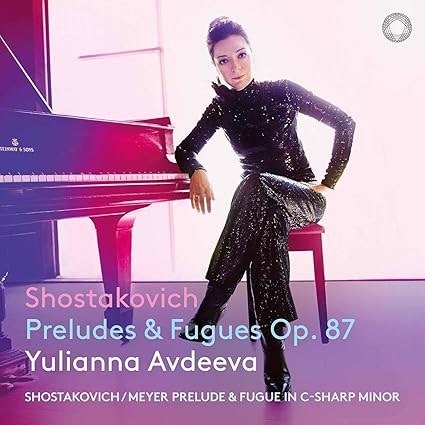

Dmitri Shostakovich (1906-1975): 24 Preludes & Fugues, Op. 87 Shostakovich/Krzysztof Meyer (b. 1943): Prelude & Fugue in C-Sharp minor (2020)
When I myself played some of these pieces many, many years ago, I promptly dismissed them as being too "bare-bones" and lacking any of the emotive depth present within this composer's symphonies. Being the impudent adolescent that I was, I completely missed the point. If you're not a musician this may be difficult to perceive, but each and every key/mode in music has a certain character, color or mood. And under the hands of a resourceful composer, these characteristics can easily be enhanced. Influenced by Johann Sebastian Bach's Well-Tempered Clavier, the 24 Preludes & Fugues, Op. 87 by Dmitri Shostakovich (1906-1975) go well beyond a mere grouping of pieces in all of the major and minor keys. They are a deeply intimate foray into the very essence of music.
They were composed in the early 1950s over a period of about six months, à la Bach, as pure, academic and formulaic music. Still, Shostakovich being who he was, darkness, desolation, irony, human emotions, spiky circus-like comical music, all of these aspects slowly crept in and became the music.
The Prelude No. 1 in C major for example, sounds like a Baroque sarabande, but after a few well placed dissonances, comes down with a case of 20th century angst. The Fugue No. 8 in F sharp minor has an atmosphere of desolation. No. 12 in G sharp minor is totally intellectual in it's harmonic fugual treatment, while some 5-part fugues are very deep and sombre. This definitely requires more meticulous and attentive listening than the Bach set, but is ultimately more rewarding.
Russian pianist Yulianna Avdeeva's highly insightful, sensitive, inquisitive, yet non-affected approach to this music is what sets her interpretation apart. In the booklet notes she states: "To me, the music in this cycle encapsulates the very essence of Shostakovich's soul and personality - no fewer than 48 distinct characters are brought to life within the cycle." When you listen to the fugue of the final No. 24 in D minor for example, you can sense a quasi religious devotion to the music under her hands as it grows and blossoms into an affirmation of life.
And no worries, the extra Prelude & Fugue in C-Sharp minor by Polish composer Krzysztof Meyer, based on an unfinished sketch by Shostakovich, doesn't in any way detract from the overall impression of this recording. As a matter of fact, its fugue is so Shostakovich-like in style and sound, that put to the blindfold test, you would swear it's one of his own.
This is music that lingers on the mind long after it's been heard, and leaves you with many unanswered questions as to its genesis and what internal forces drove Shostakovich to write it all down. Now that I'm much older and hopefully wiser, I should dust off my music book and reacquaint my fingers to its many mysteries and wonders.
Jean-Yves Duperron - July 2025 Prelude No. 6 in B minorFugue No. 17 in A-Flat major